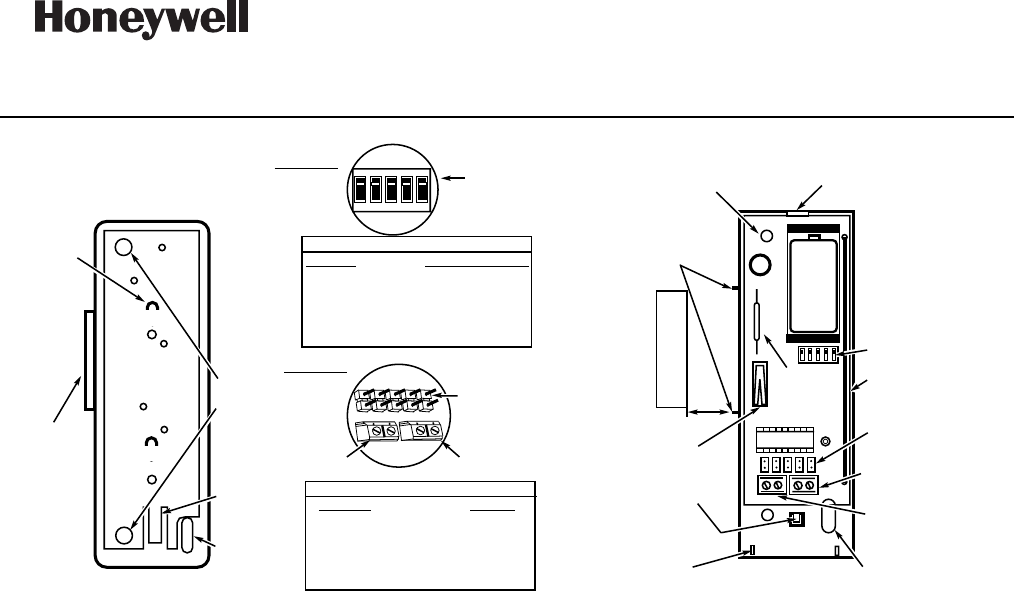Ademco 8DL5819-1 Security Remote Transmitter User Manual N7491V4 RevA
Honeywell International Inc. Security Remote Transmitter N7491V4 RevA
Ademco >
users manual with FCC Part 15 statment and FCC ID

N7491V4 7/04 Rev. A
ADEMCO 5819
SHOCK PROCESSOR TRANSMITTER
INSTALLATION AND SETUP GUIDE
A
+
–
BATTERY
REED
SWITCH
(LOOP 2)
COVER PRY-0FF POINT
ALIGN MAGNET
WITH MARKS ON
CASE AND GUIDE
ON MTG. PLATE
MAGNET
(OBTAIN
SEPARATELY)
LOOP 1 TERMINALS
(See Detail “B”)
LOCKING TAB
RELEASE WINDOW
COVER
HOLDING
HOOKS (2)
COVER
TAMPER
SWITCH
HOLES “A” (2)
(SEE TEXT)
ANTENNA
DIP SWITCHES
See Detail “A”
DIP
SWITCHES
JUMPER PINS
See Detail “B”
SLOT FOR
CONCEALED
WIRING ACCESS
A
MAGNET
Diagram 2: 5819 (SHOWN WITH COVER REMOVED)
12"
MAX
1
23
4
5
ON
TB2 TB1
MAGNETIC
ALIGNMENT
GUIDE
STRIP RELEASE
FOR
BRACKET
CASE
HOLDING
POSTS
(2)
SLOT
FOR
WIRE
SCREW
HOLES
Diagram 1: MOUNTING PLATE
TABLE 1
SWITCH RESPONSE TIME
SW1 (Most Sensitive) 1ms
SW2 2ms
SW3 5ms
SW4 10ms
SW5 (Least Sensitive) 20ms
JUMPER
PINS
SHOCK SENSOR
TERMINALS
(INPUT LOOP 1)
TABLE 2
JUMPER COUNT
J1 (Most Sensitive) 1
J2 2
J3 4
J4 6
J5 (Least Sensitive) 8
J5 J4 J3 J2 J1
DETAIL B
DETAIL A
CONTACT
TERMINALS
(INPUT LOOP 3)
LOOP 3 TERMINALS
(See Detail “B”)
5819-001-V0
GENERAL INFORMATION
The ADEMCO 5819 Shock Processor Transmitter connects to
inertia type shock detectors that are mounted externally to the
transmitter case (detector not supplied), and is intended for use
only with a wireless alarm system that supports 5800 Series
wireless receivers.
The 5819 has three unique zones. The first is for a wired,
normally closed shock sensor loop (TB1), the second is for a
closed contact loop using the unit's built-in magnetic reed switch
in conjunction with a magnet, and the third is for a wired closed
circuit contact loop (TB2).
The 5819 has a built-in cover tamper switch that activates when
the cover is removed.
INSTALLATION
Mounting
For proper orientation of the unit in relation to the mounting plate,
loop wiring, DIP switch adjustment, jumper positions, and/or
magnet, read all of this section before installing the unit.
The description that follows assumes that the unit will be mounted
as shown in the diagrams, with the magnet (if used) located to the
left of the unit. The unit can be installed in any direction, as long
as the relationship of the unit to its mounting plate and (if used)
magnet is maintained.
Although two holes are provided in the unit that would permit
mounting directly to a surface (holes "A" in Diagram 2), it is
recommended that the mounting plate be used as described
below, for ease in removing the unit for servicing should it
become necessary.
Before mounting the transmitter permanently, conduct Go/No Go
tests (see control's instructions) to verify adequate signal strength
and reorient or relocate the transmitter if necessary.
1. Remove transmitter's cover by inserting the flat blade of a
small screwdriver into the pry-off slot nearest to the cover's
decorative ribs, and twisting the blade.
2. Disengage the supplied mounting plate from the unit by
inserting the blade of a small screwdriver into the locking tab
release window (see Diagram 2) and pressing it against the
locking tab (see Diagram 1) while sliding the plate
downward along the case back.
3. If a shock processor or wired contact loop is to be used with
concealed wiring, feed the wires through the concealed
wiring entry hole at one corner of the plate. For surface
wiring entry, a thin "breakout" area is provided in the case
wall.
4. Install the mounting plate, with its case-holding posts
pointing up (in this example), in the location selected.
5. Attach the case back to the mounting plate by sliding the
keyhole slots in the case back down onto the mounting
plate's case-holding posts. The locking tab will click as the
case back locks in place.
6. If the unit's REED SWITCH is to be used, mount a 5799
Magnet (obtained separately) adjacent to the alignment
marks on the case and the mounting plate's alignment strip
(see Diagram 2).
7. Set response time (from Table 1) using the DIP switches.
SW1 sets a response time of 1mS. SW5 sets a response
time of 20mS. For a response time of 0.5mS, set all DIP
switches to OFF (as shown in DETAIL A in Diagram 1
above).
8. Set the pulse count jumper (see Table 2). The pulse count is
reset 3-seconds after the first pulse is detected. There is an
LED on the PCB that flashes rapidly on transmission.
Note: Make the device highly sensitive for the purpose
of enrolling the shock sensor loop (TB1) into the system
(turn SW1 on and put jumper on J1). After the device
has been enrolled, adjust settings as described in steps
7 and 8 (above).

WIRING CONNECTIONS
With the battery still not inserted, connect the shock processor
loop (if used) to the unit's loop TB1 terminals (see Detail "B").
The contact loops must use closed circuit devices. TB2 can be
used for normally closed contacts.
Note: If the contact loops are not used, no connection is needed
across their terminals.
"ENROLLING" THE TRANSMITTER SERIAL NUMBER
Each 5819 Shock Processor has its own unique serial number
permanently assigned during manufacture. Each input of the
transmitter also has a distinct "loop" number that must be input to
the control panel during installation. Assign each to an individual
zone and designate the Input Type as "RF" (Supervised RF).
The serial number can be input by one of the following methods:
• "Enrolled" by transmitting from the device during zone
programming (pressing the tamper switch, shorting any loop,
etc.).
• Entered through the keypad at the "Input S/N" or "Transmit
Now" prompt during manual zone programming.
• Entered through COMPASS Downloading Software and
downloaded to the control.
When programming the 5819 transmitter's serial number at
the control panel, do the following:
1. At the "Input Type" prompt, enter "3" for RF (Supervised RF).
2. When prompted for the loop number, enter the input loop you
are using (see Diagram 2). See the control panel's installation
instructions for specific programming procedures.
BATTERY INSTALLATION/REPLACEMENT
1. Remove the transmitter's cover as described in Mounting,
Step 1.
2. Observe correct polarity and insert the battery provided into
the battery holder (see Diagram 2).
3. Replace the cover, engage the hooks along one edge, and
snap shut.
Do not bend the antenna.
Note: Replace with 3V Lithium battery only: Panasonic
CR123A, Duracell DL123A, Sanyo CR123A, ADEMCO
466, or Varta CR123A.
BATTERY CAUTION: Risk of fire, explosion, and burns. Do not
recharge, disassemble, heat above 212°F (100°C), or incinerate.
Dispose of used batteries promptly. Keep away from children.
UNIT DIMENSIONS
4.8" H x 1.5" W x 1" D
TO THE INSTALLER
Regular maintenance and inspection (at least annually by the
installer) and frequent testing by the user are vital to continuous
satisfactory operation of any alarm system. The installer should
assume the responsibility of developing and offering a regular
maintenance program to the user, as well as acquainting the user
with the proper operation and limitations of the alarm system and
its component parts. Recommendations must be included for a
specific program of frequent testing (at least weekly) to insure the
system's operation at all times.
REFER TO THE INSTALLATION INSTRUCTIONS FOR THE RECEIVER/CONTROL WITH WHICH THIS DEVICE IS USED FOR
WARRANTY INFORMATION, AND FOR DETAILS REGARDING THE LIMITATIONS OF THE ENTIRE ALARM SYSTEM.
FCC STATEMENT
FCC ID: CFS8DL5819-1
This device complies with Part 15 of the FCC Rules. Operation is subject to the
following two conditions: (1) This device may not cause harmful interference (2)
This device must accept any interference received, including interference that may
cause undesired operation.
CANADA: 573F-58191
165 Eileen Way, Syosset, New York 11791
Copyright © 2004 Honeywell International Inc.
www.honeywell.com/security
ÊN7491V4qŠ
N7491V4 7/04 Rev. A